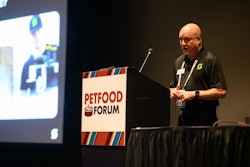
Artificial intelligence (AI) is fundamentally transforming industries and reshaping society worldwide. It’s changing the way pet food companies develop, market and sell products, connect with customers and analyze data. AI has also sped up the development of new products by leveraging predictive analytics and consumer data, and it can apply algorithms to identify trends in the food sector and predict their growth.
At Petfood Forum 2025, Hana Bieliauskas, senior vice president and partner, Inspire PR Group, will delve into how AI is transforming marketing and what the benefits, challenges and applications of it can be for pet food professionals during her education session on Tuesday, April 29.
Through pet food case studies, she will provide insights on using AI tools like ChatGPT, Gemini and Copilot to build brands, develop marketing strategies and messages, automate marketing emails, draft social media posts and target digital ads to the right people at the right times to maximize views, click-through rates and more.
The challenges of integrating AI
Companies need to embrace AI strategically and creatively to stay competitive, said Bieliauskas. Pet owners are demanding customized experiences for their pets, and brands that meet these expectations will stand out in a crowded market.
“Overall, a lack of understanding often contributes to fears about adopting AI,” said Bieliauskas. “It is vitally important that pet food companies, like other retailers, take the time to learn about the opportunities that AI offers, including increasing efficiency, assisting with creative ideation and providing valuable data insights.”
From a business perspective, companies that are not embracing AI in marketing, as well as in areas like supply chain and manufacturing, are going to be left behind.
“AI is not perfect, and it takes time to learn and to train tools,” Bieliauskas noted. “The outputs from AI tools are only as good as their inputs, so prompting AI needs to be learned and practiced.”
The information that AI tools generate is still often incorrect, so a human component is still very essential when it comes to using AI for research assistance and content development.
“Building AI tools, like chatbots or custom solutions, is costly, so it’s important to determine what role the tool will play in a marketing initiative and ensure it is built to meet specific goals,” said Bieliauskas. “Additionally, legal and ethical concerns exist, so having an AI policy is important to ensure that proprietary information is not shared in OpenAI platforms.”
Mars Petcare’s AI approach
One standout example of AI integration in pet food marketing is Mars Petcare’s innovative approach. In fall 2024, Mars announced a $1 billion investment in digital innovation, prioritizing AI.
The company’s efforts included the GREENIES campaign, “Dogs Write Reviews,” powered by an AI tool called “The Dog Interpreter.” This tool, developed in partnership with Amazon, allowed customers to scan their dogs eating GREENIES products and receive witty, AI-generated “translations” of their reactions.
Mars also used the AI tool Vizit to test the appeal of pet food packaging visuals to online consumers, resulting in a 30% increase in conversions. Insights from Vizit influenced packaging designs, tailoring them to regional preferences and boosting their effectiveness with different audience segments.
“By testing how different images score with online shoppers, Mars identified which images of pet food packages resonate best with different audience segments,” said Bieliauskas. “Mars discovered that consumers in different parts of the world have different preferences as to what makes an image appealing. The AI-generated data influenced package design, from how many pets were featured on a package to the color scheme.”
The AI evolution
AI’s role in pet food marketing is set to evolve further over the next five years. Companies are expected to harness AI’s capabilities to personalize customer experiences and predict emerging trends, aligning with the growing humanization of pets, said Bieliauskas.
“Pet food companies will continue to actively look for new and unique ways to utilize AI to personalize a customer’s experience and meet customers’ needs, building brand trust and loyalty,” she said. “We’ve seen that people are increasingly humanizing their pets, considering cats and dogs core members of the family that their owners’ lifestyles and values. Pet parents today care more about what they put in their own bodies and their unique health data, and that concern is carrying over to pets. They are actively seeking tailored dietary recommendations that address their pet's individual health and wellness requirements.”
For instance, Ollie’s acquisition of DIG Labs enabled the launch of a digital health screening tool that offers tailored dog food recommendations based on individual health data.
“Ollie’s CEO said that this approach is helping the company connect with younger pet owners, who desire tech-enabled and personalized products to improve the quality of life for their pets and themselves,” said Bieliauskas.
Similarly, Purina’s Pet Food Finder leverages AI to provide personalized product suggestions through a brief online questionnaire.
“AI integration on retailer sites helps suggest relevant products based on a person’s purchasing history, or the products they are shopping for,” said Bieliauskas. “This can analyze individual consumer preferences to suggest tailored products, enhancing customer satisfaction and loyalty.”
Embrace AI strategically and creatively to stay competitive
The most important takeaway for companies is the need to embrace AI strategically and creatively to stay competitive, said Bieliauskas.
“I want session attendees to leave feeling empowered to utilize AI and excited to see how it can enhance their marketing efforts,” she said. “I want them to try using AI tools for ideation and increasing efficiency, if they have been nervous about adopting it. For those using it, I am hoping they will be inspired to use it more strategically and creatively in their marketing initiatives moving forward.”
Pet owners are demanding customized experiences for their pets, and brands that meet these expectations will stand out in a crowded market.
“As pet owners continue to demand a more customized, personalized experience when it comes to feeding and caring for their cats and dogs, AI will be a vital tool for pet food companies in delivering that,” she added. “Those companies that offer the experience that pet owners desire are going to stand out for their ability to connect with customers and earn their long-term trust.”
By adopting AI-driven solutions to connect with customers, build trust, and deliver value, pet food companies can position themselves as leaders in an evolving industry. As the pet food landscape grows increasingly data-driven and customer-centric, AI will be a vital tool in shaping the future of the industry.
Hana Bieliauskas, senior vice president and partner, Inspire PR Group, will present her educational session, AI is transforming marketing: What are the benefits, challenges and applications for pet food? on Tuesday, April 29, at 1:30 p.m. during Petfood Forum 2025. To stay informed on the latest event developments, go to PetfoodForumEvents.com.

















